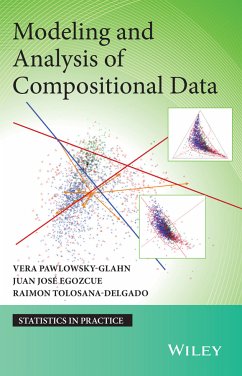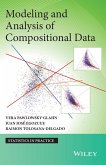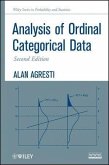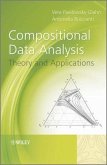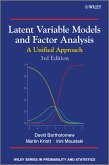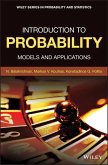Modeling and Analysis of Compositional Data (eBook, ePUB)


Alle Infos zum eBook verschenken

Modeling and Analysis of Compositional Data (eBook, ePUB)
- Format: ePub
- Merkliste
- Auf die Merkliste
- Bewerten Bewerten
- Teilen
- Produkt teilen
- Produkterinnerung
- Produkterinnerung

Hier können Sie sich einloggen

Bitte loggen Sie sich zunächst in Ihr Kundenkonto ein oder registrieren Sie sich bei bücher.de, um das eBook-Abo tolino select nutzen zu können.
Modeling and Analysis of Compositional Data presents a practical and comprehensive introduction to the analysis of compositional data along with numerous examples to illustrate both theory and application of each method. Based upon short courses delivered by the authors, it provides a complete and current compendium of fundamental to advanced methodologies along with exercises at the end of each chapter to improve understanding, as well as data and a solutions manual which is available on an accompanying website. Complementing Pawlowsky-Glahn s earlier collective text that provides an overview…mehr
- Geräte: eReader
- mit Kopierschutz
- eBook Hilfe
- Größe: 22.65MB
![Modeling and Analysis of Compositional Data (eBook, PDF) Modeling and Analysis of Compositional Data (eBook, PDF)]() Vera Pawlowsky-GlahnModeling and Analysis of Compositional Data (eBook, PDF)72,99 €
Vera Pawlowsky-GlahnModeling and Analysis of Compositional Data (eBook, PDF)72,99 €![Analysis of Ordinal Categorical Data (eBook, ePUB) Analysis of Ordinal Categorical Data (eBook, ePUB)]() Alan AgrestiAnalysis of Ordinal Categorical Data (eBook, ePUB)134,99 €
Alan AgrestiAnalysis of Ordinal Categorical Data (eBook, ePUB)134,99 €![Compositional Data Analysis (eBook, ePUB) Compositional Data Analysis (eBook, ePUB)]() Compositional Data Analysis (eBook, ePUB)91,99 €
Compositional Data Analysis (eBook, ePUB)91,99 €![Latent Variable Models and Factor Analysis (eBook, ePUB) Latent Variable Models and Factor Analysis (eBook, ePUB)]() David J. BartholomewLatent Variable Models and Factor Analysis (eBook, ePUB)70,99 €
David J. BartholomewLatent Variable Models and Factor Analysis (eBook, ePUB)70,99 €![Multivariate Analysis for the Biobehavioral and Social Sciences (eBook, ePUB) Multivariate Analysis for the Biobehavioral and Social Sciences (eBook, ePUB)]() Bruce L. BrownMultivariate Analysis for the Biobehavioral and Social Sciences (eBook, ePUB)102,99 €
Bruce L. BrownMultivariate Analysis for the Biobehavioral and Social Sciences (eBook, ePUB)102,99 €![The Art of Data Analysis (eBook, ePUB) The Art of Data Analysis (eBook, ePUB)]() Kristin H. JarmanThe Art of Data Analysis (eBook, ePUB)56,99 €
Kristin H. JarmanThe Art of Data Analysis (eBook, ePUB)56,99 €![Introduction to Probability (eBook, ePUB) Introduction to Probability (eBook, ePUB)]() Narayanaswamy BalakrishnanIntroduction to Probability (eBook, ePUB)107,99 €
Narayanaswamy BalakrishnanIntroduction to Probability (eBook, ePUB)107,99 €-
-
-
Dieser Download kann aus rechtlichen Gründen nur mit Rechnungsadresse in A, B, BG, CY, CZ, D, DK, EW, E, FIN, F, GR, HR, H, IRL, I, LT, L, LR, M, NL, PL, P, R, S, SLO, SK ausgeliefert werden.
- Produktdetails
- Verlag: Wiley
- Seitenzahl: 272
- Erscheinungstermin: 17. Februar 2015
- Englisch
- ISBN-13: 9781119003137
- Artikelnr.: 42368354
- Verlag: Wiley
- Seitenzahl: 272
- Erscheinungstermin: 17. Februar 2015
- Englisch
- ISBN-13: 9781119003137
- Artikelnr.: 42368354
- Herstellerkennzeichnung Die Herstellerinformationen sind derzeit nicht verfügbar.
About the Authors xv
Acknowledgments xix
1 Introduction 1
2 Compositional Data and Their Sample Space 8
2.1 Basic concepts 8
2.2 Principles of compositional analysis 12
2.2.1 Scale invariance 12
2.2.2 Permutation invariance 15
2.2.3 Subcompositional coherence 16
2.3 Zeros, missing values, and other irregular components 16
2.3.1 Kinds of irregular components 16
2.3.2 Strategies to analyze irregular data 19
2.4 Exercises 21
3 The Aitchison Geometry 23
3.1 General comments 23
3.2 Vector space structure 24
3.3 Inner product, norm and distance 26
3.4 Geometric figures 28
3.5 Exercises 30
4 Coordinate Representation 32
4.1 Introduction 32
4.2 Compositional observations in real space 33
4.3 Generating systems 33
4.4 Orthonormal coordinates 36
4.5 Balances 38
4.6 Working on coordinates 43
4.7 Additive logratio coordinates (alr) 46
4.8 Orthogonal projections 48
4.9 Matrix operations in the simplex 54
4.9.1 Perturbation-linear combination of compositions 54
4.9.2 Linear transformations of óKòù: endomorphisms 55
4.9.3 Other matrix transformations on óKòù: nonlinear transformations 57
4.10 Coordinates leading to alternative Euclidean structures 59
4.11 Exercises 61
5 Exploratory Data Analysis 65
5.1 General remarks 65
5.2 Sample center, total variance, and variation matrix 66
5.3 Centering and scaling 68
5.4 The biplot: a graphical display 70
5.4.1 Construction of a biplot 70
5.4.2 Interpretation of a 2D compositional biplot 72
5.5 Exploratory analysis of coordinates 76
5.6 A geological example 79
5.7 Linear trends along principal components 85
5.8 A nutrition example 89
5.9 A political example 96
5.10 Exercises 100
6 Random Compositions 103
6.1 Sample space 103
6.1.1 Conventional approach to the sample space of compositions 105
6.1.2 A compositional approach to the sample space of compositions 106
6.1.3 Definitions related to random compositions 107
6.2 Variability and center 108
6.3 Probability distributions on the simplex 112
6.3.1 The normal distribution on the simplex 114
6.3.2 The Dirichlet distribution 121
6.3.3 Other distributions 127
6.4 Exercises 128
7 Statistical Inference 130
7.1 Point estimation of center and variability 130
7.2 Testing hypotheses on compositional normality 135
7.3 Testing hypotheses about two populations 136
7.4 Probability and confidence regions for normal data 142
7.5 Bayesian estimation with count data 144
7.6 Exercises 147
8 Linear Models 149
8.1 Linear regression with compositional response 150
8.2 Regression with compositional covariates 156
8.3 Analysis of variance with compositional response 160
8.4 Linear discrimination with compositional predictor 163
8.5 Exercises 165
9 Compositional Processes 172
9.1 Linear processes 173
9.2 Mixture processes 176
9.3 Settling processes 178
9.4 Simplicial derivative 183
9.5 Elementary differential equations 186
9.5.1 Constant derivative 187
9.5.2 Forced derivative 189
9.5.3 Complete first-order linear equation 194
9.5.4 Harmonic oscillator 200
9.6 Exercises 204
10 Epilogue 206
References 211
Appendix A Practical Recipes 222
A.1 Plotting a ternary diagram 222
A.2 Parameterization of an elliptic region 224
A.3 Matrix expressions of change of representation 226
Appendix B Random Variables 228
B.1 Probability spaces and random variables 228
B.2 Description of probability 232
List of Abbreviations and Symbols 234
Author Index 237
General Index 241
About the Authors xv
Acknowledgments xix
1 Introduction 1
2 Compositional Data and Their Sample Space 8
2.1 Basic concepts 8
2.2 Principles of compositional analysis 12
2.2.1 Scale invariance 12
2.2.2 Permutation invariance 15
2.2.3 Subcompositional coherence 16
2.3 Zeros, missing values, and other irregular components 16
2.3.1 Kinds of irregular components 16
2.3.2 Strategies to analyze irregular data 19
2.4 Exercises 21
3 The Aitchison Geometry 23
3.1 General comments 23
3.2 Vector space structure 24
3.3 Inner product, norm and distance 26
3.4 Geometric figures 28
3.5 Exercises 30
4 Coordinate Representation 32
4.1 Introduction 32
4.2 Compositional observations in real space 33
4.3 Generating systems 33
4.4 Orthonormal coordinates 36
4.5 Balances 38
4.6 Working on coordinates 43
4.7 Additive logratio coordinates (alr) 46
4.8 Orthogonal projections 48
4.9 Matrix operations in the simplex 54
4.9.1 Perturbation-linear combination of compositions 54
4.9.2 Linear transformations of óKòù: endomorphisms 55
4.9.3 Other matrix transformations on óKòù: nonlinear transformations 57
4.10 Coordinates leading to alternative Euclidean structures 59
4.11 Exercises 61
5 Exploratory Data Analysis 65
5.1 General remarks 65
5.2 Sample center, total variance, and variation matrix 66
5.3 Centering and scaling 68
5.4 The biplot: a graphical display 70
5.4.1 Construction of a biplot 70
5.4.2 Interpretation of a 2D compositional biplot 72
5.5 Exploratory analysis of coordinates 76
5.6 A geological example 79
5.7 Linear trends along principal components 85
5.8 A nutrition example 89
5.9 A political example 96
5.10 Exercises 100
6 Random Compositions 103
6.1 Sample space 103
6.1.1 Conventional approach to the sample space of compositions 105
6.1.2 A compositional approach to the sample space of compositions 106
6.1.3 Definitions related to random compositions 107
6.2 Variability and center 108
6.3 Probability distributions on the simplex 112
6.3.1 The normal distribution on the simplex 114
6.3.2 The Dirichlet distribution 121
6.3.3 Other distributions 127
6.4 Exercises 128
7 Statistical Inference 130
7.1 Point estimation of center and variability 130
7.2 Testing hypotheses on compositional normality 135
7.3 Testing hypotheses about two populations 136
7.4 Probability and confidence regions for normal data 142
7.5 Bayesian estimation with count data 144
7.6 Exercises 147
8 Linear Models 149
8.1 Linear regression with compositional response 150
8.2 Regression with compositional covariates 156
8.3 Analysis of variance with compositional response 160
8.4 Linear discrimination with compositional predictor 163
8.5 Exercises 165
9 Compositional Processes 172
9.1 Linear processes 173
9.2 Mixture processes 176
9.3 Settling processes 178
9.4 Simplicial derivative 183
9.5 Elementary differential equations 186
9.5.1 Constant derivative 187
9.5.2 Forced derivative 189
9.5.3 Complete first-order linear equation 194
9.5.4 Harmonic oscillator 200
9.6 Exercises 204
10 Epilogue 206
References 211
Appendix A Practical Recipes 222
A.1 Plotting a ternary diagram 222
A.2 Parameterization of an elliptic region 224
A.3 Matrix expressions of change of representation 226
Appendix B Random Variables 228
B.1 Probability spaces and random variables 228
B.2 Description of probability 232
List of Abbreviations and Symbols 234
Author Index 237
General Index 241
